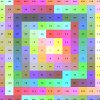Number Theory Seminar
Given any algebraic variety X over a number field, it is conjectured that there exists a finite collection of automorphic forms f_0, ..., f_m such that the Hasse--Weil zeta function zeta(X, s) of X is some product/quotient of the automorphic L-functions L(f_i, s). The most famous example of this correspondence is when X is an elliptic curve over Q, in which case the Modularity Theorem (a.k.a. Taniyama--Shimura--Weil conjecture) is required to find the f_1, which turns out to be a modular form of weight two. The methods involved in proving this result have been vastly extended, but determining the collection of f_i's is only known for very restricted classes of varieties over very restricted types of fields. Furthermore, such proofs usually take as their starting point only one (admittedly important) invariant: a Galois representation associated with X, usually obtained via an appropriate version of etale cohomology.
In this talk, we want to look at a sort of "enhanced converse" question. Namely, there are many other "finer" invariants associated with such a space X, such as its K-theory, its Chow group, its derived category of coherent sheaves, etc. Does the modularity (a.k.a. automorphy) of the variety allow us to say anything about these invariants? To illustrate this, we'll focus about a certain distinguished class of surfaces. We will show how modularity in this context allow us to use number-theoretic arguments and constructions to great effect and indicate some strange questions that the results (and roadblocks) raise in the process.
